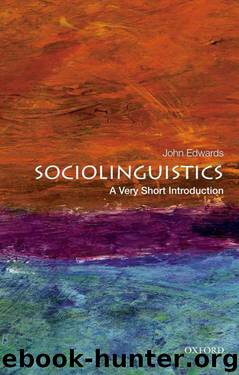Sociolinguistics: A Very Short Introduction (Very Short Introductions) by Edwards John

Author:Edwards, John [Edwards, John]
Language: eng
Format: epub, azw3, mobi
Publisher: Oxford University Press, USA
Published: 2013-07-10T21:00:00+00:00
Chapter 6
Loyalty, maintenance, shift, loss, and revival
All languages and all dialects are bearers of identity; all can have a psychological and symbolic significance that accompanies their more obvious communicative value. Speakers of big languages need hardly consider this. Minority-group members, however, rarely have the luxury of neglect here: for them, the instrumental and symbolic aspects of their language often become disengaged. This is why sociolinguistics pays closer attention to them than to “mainstream”-group members: the greater cultural and linguistic fragility of small groups tends to throw linguistic matters into sharper relief. The most obvious and therefore the most studied of such groups are ethnonational communities that have become minorities in their own country—through invasion, federation, partition. or other state-altering arrangements—or which have become small through migration.
Arguments have been made that different adaptations ought to be made for these two sorts of groups. Perhaps indigenous communities merit more official attention, greater social benefits or wider political autonomy, on the assumption that they are “autochthonous”’ (“of the soil”) and were “here first.” Perhaps immigrant groups should expect a little less; after all, they moved and, in all but unconscionable instances, they did so voluntarily. Since there are clear linguistic aspects here, a little digression is in order, to point out that matters are less than clear-cut—as they are for the designation “minority” itself.
Is French in Canada a minority language, for example? The answer depends on the geographic perspective (provincial, regional, continental) that one adopts. And what about minorities within minorities? The aboriginal groups in Québec come to mind here, as do the Abkhazian and Ossetian enclaves within the former Soviet republic of Georgia. In many cases, groups of minority status are not particularly sensitive to the perceived plight of still smaller communities within them. Many Québécois nationalists who argue for the right to secede from Canada would deny that same course of action to the James Bay Cree. Numbers are also important in determining minority status, but they are not the whole story nor its most important element. Native language groups in South Africa have always vastly outnumbered speakers of English and Afrikaans, but those groups were of marginal status. It is clear that historically subaltern rank has much more to do with power than with population.
The most obvious point of comparison between indigenous and immigrant minority groups is that the former retain their residence on an ancestral home territory, something that may encourage cultural continuity, even with the loss of power and status. But there are complicating factors here, chief among which is the temporal dimension. Among the present-day Tamils of Sri Lanka, some came to the island a thousand years ago, while others moved there in the mid-nineteenth century. Are some indigenous and others not? How will we regard the apparently permanent Gastarbeiter (“guest workers” of the 1960s and ’70s) in Europe five hundred years hence? Are the Welsh and Bretons truly indigenous in the lands they now live in? Were they not historical interlopers in some earlier age? If
Download
Sociolinguistics: A Very Short Introduction (Very Short Introductions) by Edwards John.azw3
Sociolinguistics: A Very Short Introduction (Very Short Introductions) by Edwards John.mobi
This site does not store any files on its server. We only index and link to content provided by other sites. Please contact the content providers to delete copyright contents if any and email us, we'll remove relevant links or contents immediately.
Cecilia; Or, Memoirs of an Heiress — Volume 1 by Fanny Burney(32434)
Cecilia; Or, Memoirs of an Heiress — Volume 2 by Fanny Burney(31868)
Cecilia; Or, Memoirs of an Heiress — Volume 3 by Fanny Burney(31852)
The Lost Art of Listening by Michael P. Nichols(7403)
Asking the Right Questions: A Guide to Critical Thinking by M. Neil Browne & Stuart M. Keeley(5630)
We Need to Talk by Celeste Headlee(5542)
On Writing A Memoir of the Craft by Stephen King(4863)
Dialogue by Robert McKee(4321)
Pre-Suasion: A Revolutionary Way to Influence and Persuade by Robert Cialdini(4144)
I Have Something to Say: Mastering the Art of Public Speaking in an Age of Disconnection by John Bowe(3838)
Elements of Style 2017 by Richard De A'Morelli(3306)
The Book of Human Emotions by Tiffany Watt Smith(3237)
Fluent Forever: How to Learn Any Language Fast and Never Forget It by Gabriel Wyner(3024)
Name Book, The: Over 10,000 Names--Their Meanings, Origins, and Spiritual Significance by Astoria Dorothy(2938)
Good Humor, Bad Taste: A Sociology of the Joke by Kuipers Giselinde(2902)
Why I Write by George Orwell(2874)
The Art Of Deception by Kevin Mitnick(2735)
The Grammaring Guide to English Grammar with Exercises by Péter Simon(2706)
Ancient Worlds by Michael Scott(2622)
